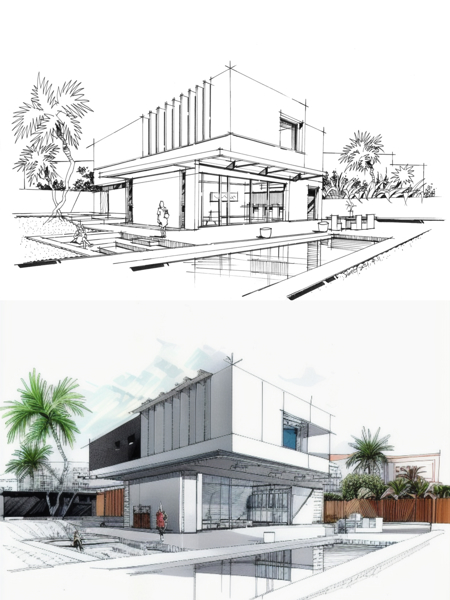Recognizing the Collaborative Process In Between Architects and Engineers in Modern Building And Construction Projects
The collaborative process in between designers and designers is crucial in contemporary construction projects, as it integrates design intent with engineering expediency. Exploring these dynamics discloses understandings that might dramatically influence task results and total market requirements.
The Importance of Collaboration
The collective harmony between architects and designers is important for the effective awareness of any type of building job. This collaboration unites distinctive proficiency and point of views, enabling the combination of cutting-edge style with useful design options. By collaborating, designers and engineers can ensure that a task not only fulfills visual and functional needs however likewise sticks to safety, sustainability, and monetary restraints.
Collaboration cultivates a common vision, facilitating the positioning of objectives and expectations from the outset. This alignment is crucial in resolving prospective difficulties and mitigating risks that might develop during the task lifecycle. A joint approach permits for the reliable appropriation of resources, maximizing both time and cost.
The relevance of collaboration encompasses the iterative process of design and construction, where comments from engineers can notify architectural choices, causing more feasible and sustainable designs. Alternatively, engineers can influence designers to think artistically regarding how to achieve structural stability without endangering imaginative intent. Ultimately, the collaborative partnership in between designers and designers is not merely beneficial; it is fundamental to the production of top notch, functional, and cutting-edge built atmospheres that meet the needs of culture.
Interaction Techniques and Tools
Efficient communication strategies and tools are crucial for fostering partnership between architects and engineers throughout the job lifecycle. Establishing clear networks of interaction is important to make sure that all group members are straightened with task goals, timelines, and responsibilities. Regular meetings, both in-person and online, offer chances for stakeholders to discuss development, address problems, and make educated decisions.

Furthermore, taking on collaborative interaction tools, such as Slack or Microsoft Teams, permits instantaneous messaging, file sharing, and ongoing conversations, advertising an extra agile response to arising problems. File monitoring systems likewise play a critical role in arranging job documents, making certain that all employee have access to the most recent info.
Shared Objectives and Job Vision
A merged job vision serves as the foundation for effective partnership in between designers and engineers (cda architects). This shared vision not just aligns the initiatives of both events yet also develops a common structure for decision-making throughout the project's lifecycle. By expressing clear goals, stakeholders can properly browse the intricacies of modern building jobs, ensuring that both visual and functional demands are satisfied
Establishing shared objectives includes open discussion and a thorough understanding of each technique's payments. Engineers typically concentrate on design intent, spatial partnerships, and individual experience, while engineers stress structural integrity, systems capability, and compliance with laws. When these viewpoints are straightened, the result is a cohesive task that abides by both creative ambitions and technological usefulness.
Furthermore, a distinct task vision cultivates accountability among employee, urging look these up each participant to take possession of their role in accomplishing the preferred outcome. Normal check-ins and collaborative workshops can even more enhance this commitment, permitting changes to be made as the project advances. Ultimately, a shared vision not just improves team effort yet likewise elevates the quality of the final deliverable, leading to effective task conclusion.
The Role of Innovation
Leveraging modern technology has become essential in boosting partnership between engineers and designers. Building Details Modeling (BIM) stands out as a critical innovation, enabling both designers and designers to develop in-depth 3D designs that envelop design intent and architectural integrity.
Furthermore, cloud-based platforms enable smooth cooperation, permitting project stakeholders to gain access to and upgrade task information from anywhere. This promotes a culture of openness and liability, as modifications can be tracked and assessed in real-time. Furthermore, mobile applications additional enhance communication, offering on-site teams with instant accessibility to job requirements and updates.
Emerging technologies such as expert system and artificial intelligence are also starting to contribute in anticipating evaluation, helping teams determine potential concerns before they arise. Eventually, the duty of modern technology in architecture-engineering cooperation not just boosts process efficiencies however likewise boosts development, causing even more effective task outcomes. By welcoming these technological improvements, engineers and designers can guarantee a much more natural and efficient collaborative process throughout the building and construction lifecycle.
Study in Effective Collaborations
Numerous case researches illustrate the profound effect of reliable collaborations between engineers and designers on task end results. One notable example is the collaboration on the High Line in New York City, where landscape engineers, designers, and metropolitan organizers interacted to change an abandoned rail line right into a vibrant public park. This multidisciplinary method not only enhanced the aesthetic high quality but also ensured structural safety and security and ecological sustainability.

The Burj Khalifa in Dubai additionally demonstrates the importance of collaborative efforts - cda architects. The integration of style and engineering competence made it possible for the project team to achieve unprecedented heights while go to my blog sticking to safety guidelines and aesthetic vision
These instances emphasize the significance of interaction, trust fund, and shared purposes. In today's complicated building environment, such collaborations are vital to navigating challenges and supplying jobs that satisfy both functional and visionary goals.
Conclusion
To conclude, the partnership between architects and designers is important for the success of contemporary building and construction jobs. Effective communication strategies, a common project vision, and the assimilation of innovative innovations are important components that promote this collaboration. By fostering a culture of accountability and leveraging devices such as Continue Building Information Modeling (BIM), groups can navigate task complexities, ensuring that visual, practical, and sustainability objectives are attained. Inevitably, this harmony causes ingenious and effective project results.
Comments on “The Creative Refine Behind Successful Tasks from CDA Architects”